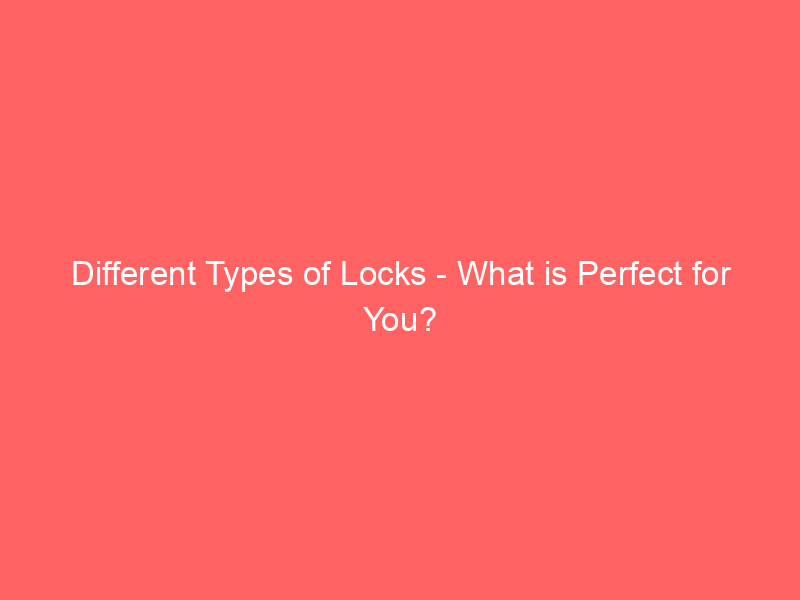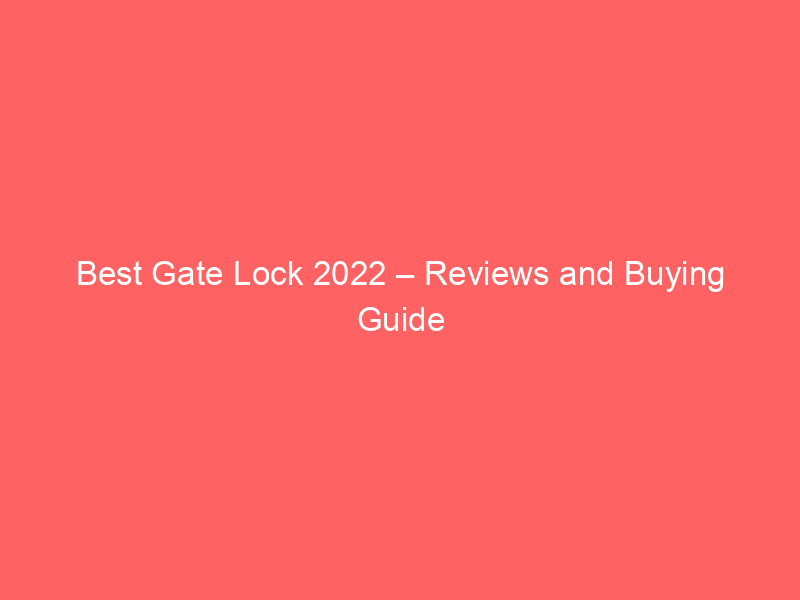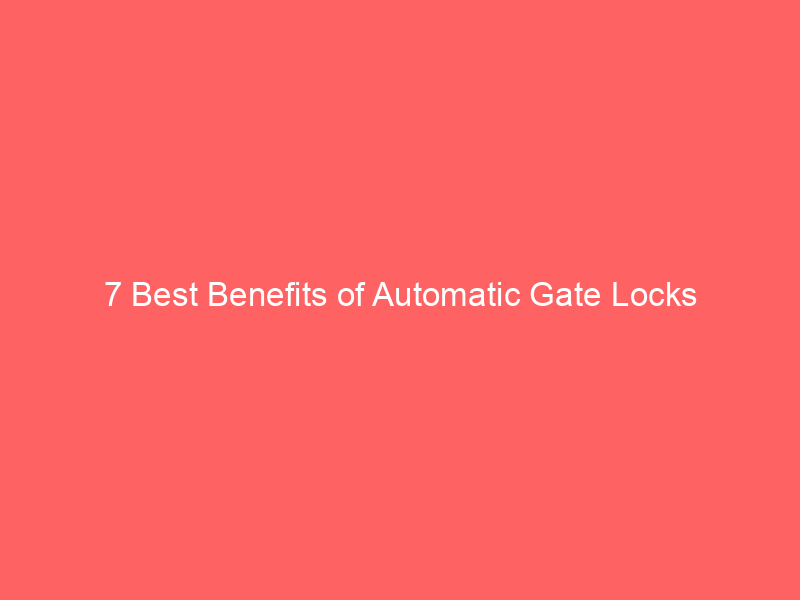Locks are not just some missing piece of your doors.
Yes, but absolutely essential for securing your home and properties.
Odds are, before now, you probably didn’t pay attention to the type of lock you have.
Or the level of security it offers.
So, you have to learn more about types of locks.
Different Types of Locks in the Market
There are different types of locks in the market with varying degree of security. In order to ensure you have the best lock for your gate. It is essential you know the kind of security features it offers.
The purpose of this article is to help you understand the various types of Locks. And how to pick the right one for your gate based on security considerations.
Without wasting any more time, let’s dive in!
1. Mortise Locks
If a lock is fitted into the edge of a door, and it’s only possible to see the for end. Then the lock is a mortise lock. A pocket-like cut is made into the edge to accommodate the lock in the door. This pocket cut is what is referred to as mortise.
Although there are various types of mortise lock. The most common variants are:
— the sashlock and
— the deadlock.
Both locks basically utilize a deadlock. The sashlock also featuring a latch bolt that helps to maintain the closed position of the door.
To lock the door, the key is turned to move the deadbolt into the frame keep. A pair of knobs or any other suitable handles can be found on the sides of the door. Because its need to operate the latch bolt.
It’s important to note that mortise locks do not ordinarily work well with sliding doors. And instead of this, a lock and any one of a claw bolt or hook is preferable.
Mortise locks are ideal for residential gates, especially priority gates such as your home main gate. Its need to provide improved security against burglars. This is important especially if your gate is not kick-proof or pick-proof.
2. Combination Locks
Any lock that requires users to enter a sequence of letters, numbers or symbols before it can be opened is known as a combination lock.
Although there are several ways of entering the sequence, the rotating dial and the keypad entry are the most common methods. In the same manner, the combination lock can cone in the form of a single dial, multiple dial or it could be electronic.
Single dial combination locks are mostly used in school lockers, padlocks and safes, while the multiple dial combination locks can be found in luggages, bikes and briefcases.
Electronic locks are similar to single dial locks in terms of design, however, the mode of entering the sequence is quite different. In the latter, a keypad is used instead of a dial.
In safe locks, you have to turn a dial to enter the combination code before the safe door can be opened.
3. Biometric Locks
A biometric lock is a more advance form of security set up that requires a fingerprint for accessibility to a certain restricted area. It usually comes with a scanner which could either be optical or thermal. The scanner scans and verify users’ finger prints before access can be granted.
To operate a biometric lock, you need a power source which could be from a battery or your normal home electric supply.
Various technologies are adopted by different biometric locks to carry out their function. For instance, optical biometric locks essentially capture your finger print and try to match this picture with the one already stored in its database.
Since it only requires a picture of your finger for verification, anyone can easily manipulate the system with a picture of your fingerprint.
Herein, the most reliable scanning technology is the ultrasound scanner which uses sound waves to read the inner layer of your fingerprints.
4. Cylindrical Locks
Unlike a mortise lock which requires a pocket cut to be made in the edges of a door, a cylindrical lock requires a hole to be through the whole door. This is what basically distinguishes the cylindrical lock from its counterparts.
Each end of the cylindrical lock has a knob or lever whose function is to retract the latch on the door lock whenever it’s turned.
Most of the time, cylindrical locks are installed by boring two holes through the door; a larger one from the face or front of the door and a smaller one from the side of the door.
A metal bar goes into the small hole whenever a key is used on the lock. The lock can be opened by turning the knob. In the case of a lever head, you will be required to press it.
In other words, the locking mechanism is two fold. The entire installation process is known as the “boring” method.
Cylindrical locks come in various styles and finishes which give you the chance to choose a lock that blends with the color or style of your house.
This type of lock can be used in both residential and commercial buildings, however it might not offer a high level of security, since it is vulnerable to breaking or picking.
5. Knob Locks
Knob locks are the most commonly used door lock in residential settings. Sometimes they might be installed to complement deadbolts on exterior doors.
This type of lock basically has its cylinder in its knob instead of the door. The key cylinder is located on one side of the lock while the knob is found on the other that’s in charge of the locking mechanism.
This is why it is not recommended to use them as the chief method of security for external doors, as its very easy to get behind such doors with basic tools like pliers, screwdriver, wrench or hammer.
So except you are exclusively using them for your interior doors between rooms, it’s always a good idea to use them together with a secondary lock to help them resist brute force attacks. A good example of a secondary lock you can use for this purpose is a deadbolt.
Besides forced break in, knob locks are also prone to shimming and picking.
6. Cam Locks
A cam lock is mostly used in fully constructed cabinets and often hidden away from sight in other not to affect the outward appearance. Just like any other lock or fastener, they are used to secure items, especially sensitive materials.
Cam locks are often cylindrical and are inserted into the cabinet wood or any other furniture wood. They are usually cheap and come with cylindrical base that consists of keyhole and a metal tube known as the cam.
Most cam locks are usually positioned at joints for improved security. And usually require a key for them to be opened.
7. Deadbolt Locks
If you’re looking a budget-friendly way to secure all your external doors, then the deadbolt lock can be a great option.
This type of lock comes with a keyhole on the outside which pushes a bolt in the lock cylinder sideways when turned with a key. The door gets locked as the cylinder causes the bolt to thrust forward into its frame.
The strike plate in the door frame helps to secure the door against forced entry to keeping the bolt in position and ensuring it doesn’t rip through the frame when subjected to a lot of pressure, such as in the case of a burglar trying to force his way through.
This is what makes deadbolt locks reliable for exterior doors. As we indicated earlier, they can be used in addition to knob locks.
Apart from doors, this type of lock can also be used for cabinet drawers.
How to Pick A Lock?
Its hard to make a decision from our side. Because we don’t know your requirement. So read different types of locks descriptions and then try to understand what type of lock you need. Hope, then, you can understand easily that which type of lock you need.
For example, if you have an automatic gate of your home, you should choose an automatic lock for you. But if you are looking for gate hardware tools, you should go with any type of lock we described above.
And sometimes, your lock type can be depend on your gate latch type. So before purchase your lock, you must check your gate latch category to make your choice perfect.
Conclusion
Though there are other types of locks out there, the ones discussed here are some of the most popular ones. In fact, the number above is just a tip of the iceberg, but it’s definitely a good way to get started. We hope you will find one of the locks perfect for the particular application you have in mind.
But just in case you have any questions, do well to let us know in the comments.




